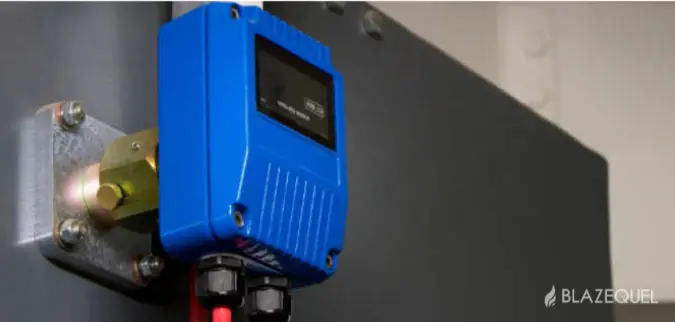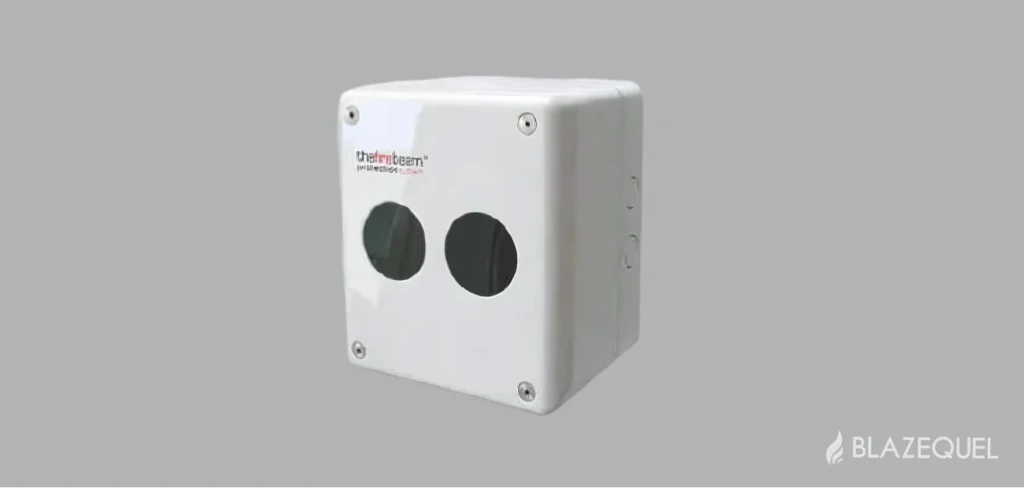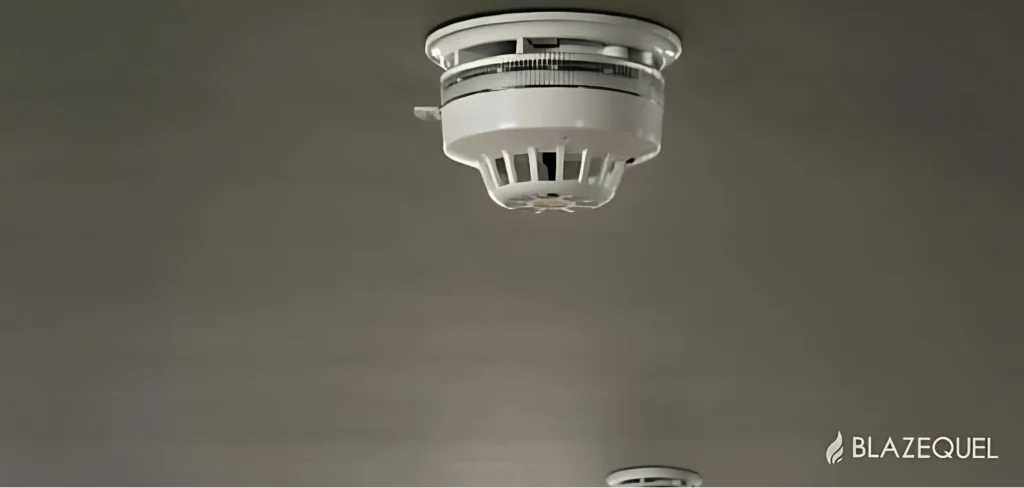Tipping Halls & Bulk Storage Bays
Tipping Halls & Bulk Storage Bays
Tipping Halls are a key risk area for recycling facilities. You never really know what’s arriving in your tipping hall and any delivery could include a battery, gas canister, hot load or other hazard. Vigilance, plus early fire detection and suppression is key.
Large piles of flammable material and an ever-changing stockpile layout create a complex environment for detection and suppression of fires.
For the protection of tipping halls, we use a variety of technologies depending on the requirements of the facility.
Table of Contents
Detection Methods
Flame Detection
Flame detection is ideal for the protection of waste tipping halls. However, there are some drawbacks that you need to consider when selecting this solution for your application.

Why use flame detection for waste tipping halls:
- Simple, reliable and cost-effective protection.
- Flame detectors can cover a large area (up to 50m for top spec models).
- Flame detectors are resilient to false alarm sources, such as sunlight, vehicle lights, hot exhausts and welding.
- Flame Detectors can see through dust/fumes/steam and other common environmental conditions which occur in tipping halls. This makes them very suitable for harsh environments.
Disadvantages of flame detection in waste tipping halls:
- First and foremost is the fact that by the time the detector activates you have a ‘fire’ – that’s probably acceptable if it’s a surface fire you’ve just detected – like an exploding lithium-ion battery. However, if it’s a deep-seated fire which has been smoldering all night and has only just broken the surface, you may have lost the ability to detect the fire early – more on this below with our other two key detection methods.
- Secondly, flame detectors are optical detectors which require line-of-sight to the fire. Therefore, if you have lots of bunker walls or machinery obstructions your line of sight may be blocked until the fire has grown. Care must be taken when designing a flame detection system to minimize this risk.
- Finally, maintenance is key – we have seen flame detectors caked in dust and cobwebs which would render them incapable of rapidly detecting a fire.
Video Smoke Detection
Video smoke detection (VSD) is a fantastic solution for early fire detection in waste tipping halls, which works by analysing CCTV footage for signs of smoke and fire. It provides a resilient form of early fire detection, which crucially is less dependent on a line-of-sight to the fire than either thermal or flame detection.
Why use video smoke detection in waste tipping halls:
- VSD can withstand the harsh operating environment of a waste tipping hall. Most smoke detection systems cannot cope with the operating environment of a tipping hall, and deteriorate over time. With video smoke detection, all you have to do is keep the camera lens clean!
- Detection at the source of the fire – VSD is the only form of smoke detection which does not require the smoke to reach the roof. This is key, because in recycling halls the roof is generally very high. Therefore if the smoke reaches the roof at all, it may not reach the roof until a significant fire has developed – read more about this challenge here>>.
- Video smoke detection can ‘learn’ its environment, adapting to the operational conditions and site activities such as steamy waste materials, dust from vehicle movements etc.
Disadvantages of video smoke detection in waste tipping halls:
- Some dust events just ‘look’ like smoke and may cause false alarms.
- Annual software licencing fees.
- Higher implementation costs than flame detection.
Thermal Fire Detection
Thermal fire detection is widely used in waste tipping holes, and for good reason. However, thermal fire detection (TFD) is also widely misunderstood or ‘over-sold’ for recycling applications, so here we’ll help you understand what thermal fire detection is (and isn’t) good for.
Thermal fire detection is basically a combination of thousands of temperature sensors, in a camera. The sensors combine to create an ‘image’ where the temperature identified by each sensor is shown as a colour. Therefore, a thermal ‘image’ is really just a coloured temperature graph.
Why use thermal fire detection in waste tipping halls:
- Thermal fire detection can provide early warning of a developing fire – in the right conditions.
- As it is an optical detection device, it also is unaffected by its operating environment, making it a resilient long-term solution.
- Thermal detection can see through dust, steam and smoke. Therefore, it is unaffected by harsh operating conditions and if you do have a fire, the thermal image can be used to identify the hotspots where the fire is located.
Disadvantages of thermal fire detection in waste tipping halls:
- Thermal fire detection detects the surface temperature of an object. Contrary to common belief, TDF cannot penetrate into piles or see through walls.
- Thermal fire detection is line-of-sight only. Taking a deep seated fire in a stockpile as an example, if the surface of the stockpile is a reflection of the temperate below, then the thermal camera will be able to detect that heat abnormality. However, different types of waste material conduct heat differently, and many wastes (MSW, RDF, SRF) are self-collapsing and self-insulating. This prevents heat from being transferred predictably to the surface of the pile where it can be detected. In this type of environment, VSD is likely to be more effective than video smoke detection!
- Just because your thermal camera can ‘see’ a heat abnormality does not mean it will activate your alarm system. There is a fine line to be drawn between early warning and a system that ‘cries WOLF’ too often! Like the fabled shepherd boy, most TFD systems have their sensitivity reduced to the point where they are no better than a flame detection system – only activating when a visible fire appears. This is due to the multitude of false alarm sources at most recycling facilities, with mobile plant machinery in particular causing challenges with hot exhausts causing false alarms.
What is the ‘best’ fire detection system for waste tipping halls?
By now, you’ve probably guessed that there isn’t one. Each of the above detailed detection methods has its strengths and weaknesses. For the best detection, you really need all three of the detection methods detailed above (flame, video smoke and thermal fire detection).
That’s exactly what you get with our Fire Rover system. Better still, with the remote human alarm filtering we can set the trigger thresholds low enough to get false alarms. Those alarms are intercepted by trained operators at our monitoring centres, ensuring there is no disruption to your site operations.
What fire detection systems should you not use in waste tipping halls?
As a general rule, we always avoid installing the following forms of fire detection in tipping halls. Even though they may appear to be a ‘cheaper’ option, unless the environment is very clean you can end up with a system which does not stand the test of time, creating a poor investment that needs to be replaced.
Aspirating Smoke Detection
ASD systems work by constantly sucking air samples from the protected area through a set of plastic conduits to a detection unit for analysis, looking for traces of smoke in the air sample.
In a damp and dusty environment, the sampling pipework can quickly become clogged with dirt and condensation – which in turn leaves the system inoperable. Yes, you can install automatic blow-through systems to help keep the pipework clean, but over time the environment will take its toll on the system. ASD is great for cleaner environments (we even recommend it for some MRF applications)…. but very rarely would we suggest ASD in the tipping hall!
Furthermore, if you have a high-roofed tipping hall you need to consider the risks of Stratification! If the smoke doesn’t reach the roof, your ASD won’t detect it anyway. Read more about stratification here>>.
Beam Detectors
Beam detectors are not suitable for waste tipping halls. The dust, condensation and vehicle fumes common in these areas create faults and false fire alarms on the system. Wherever beam detectors are used for waste tipping halls, they are generally turned off during the day. This means that someone needs to remember to turn them off / on at the start and end of the shift, plus means that you only have detection during the night! Assuming that someone will spot a fire during the day is a high risk strategy.
That’s exactly what you get with our Fire Rover system. Better still, with the remote human alarm filtering we can set the trigger thresholds low enough to get false alarms. Those alarms are intercepted by trained operators at our monitoring centres, ensuring there is no disruption to your site operations.

Point-Type Heat Detectors
Point detectors are designed for use in offices and small areas. As a general rule, they should not be used in tipping halls (whether they are rate of rise or fixed temperature). Most tipping halls have high roofs, and by the time a heat detector operates you will have an established and growing fire – probably too late to take action to contain the incident.

Fire Suppression for Waste Tipping Halls:
The key challenge when designing a fire suppression system for a waste tipping hall, is the ever–changing layout and storage height of material. This environment requires a suppression system which can accommodate the changing fire hazards. This is the key reason why water cannon systems such as Fire Rover are so suitable for tipping holes.
Challenges for tipping hall fire suppression:
- Your stockpiles move, and change in size, shape and volume.
- The fire load can be different with every delivery, due to different material sources.
- High roofed buildings create an environment where fire sprinkler systems are unlikely to provide any early fire suppression. As a general rule, sprinklers should be considered your second line of defence in tipping hall areas.
- Storage in bunkers is a good principle – but remember that fires are equally likely to happen whilst tipping or loading in the middle of the hall. Your fire suppression or fire strategy needs to cover those areas too!
- Bunker walls are only effective as fire breaks if materials are not overflowing the top or sides of the bunker.
- If your bunker walls may move, consider the effect that this would have on your fire suppression design. Deluge systems are not easy to retrospectively move! Water cannon systems are much more adaptable.
- If you have a deep-seated fire, you will almost certainly have to excavate the material out layer-by-layer using your plant machinery to thoroughly extinguish the fire. Make sure your fire suppression system will help you in that scenario.
Bearing all those challenges in mind, we can now take a look at the different forms of fire suppression which are commonly used in tipping hall applications.
Fire Sprinkler Systems
Fire sprinkler systems are triggered when the heat of a fire ruptures the glass bulb in a sprinkler head. Sprinkler systems are simple, reliable and have proved their worth countless times. However, consider the following:
Benefits of sprinkler systems in waste tipping halls:
- Simplicity. In an environment which is harsh and maintenance can be challenging, a sprinkler system is simple and reliable.
- No zoning. Sprinkler systems provide blanket coverage across the whole protected area. Therefore, if the storage or operational layout changes this does not affect the design or operation of the sprinkler system (so long as the original design fundamentals of the system and facility such as storage size, height and material commodity are respected).
- Low maintenance. Again, this is a key benefit in a harsh and busy operational environment where access for maintenance is a challenge.
- Structural protection. We often see sprinklers used as a (secondary) structural protection system, where the building framework is protected using sprinklers whilst ‘active’ suppression methods such as deluge / cannons are used for primary control of the fire.
- Sprinklers are most effective when used with other forms of fire suppression. We advocate the use of sprinkler protection around MRF areas where this provides effective coverage in all the nooks and crannies of the plant.
Drawbacks of sprinkler systems in waste tipping halls:
- A typical sprinkler head for a recycling facility would be anywhere from 65-141°C. The problem is, that in a tipping hall that sprinkler head could be anywhere up to 15 metres high! By the time the heat of a fire triggers that head (if it ever does) a significant fire could have developed.
- Heat migration. In open tipping halls where there is a lot of airflow, the heat of a fire may move diagonally upwards. This means that the area of the roof in which the heat gathers and activates the sprinkler head could be a different area to the fire below. Your sprinkler system will not be effective in this scenario!
- Fire development time. The time taken for a fire to develop and trigger a sprinkler head at high level significantly reduces the chance of quick suppression. Automatic fire detection and targeted extinguishing of the fire via a water cannon will have a much higher chance of a successful outcome.
- Water usage. A fire sprinkler system uses 88% more water than a targeted cannon system. Many sites simply do not have the space to capture/control the fire water which would be created by a sprinkler system – this creates a significant pollution risk.
- Fire suppression technique – a sprinkler (or deluge) system will continue to discharge until manually stopped. However, a deep seated fire is not extinguished by just applying more water, so once the surface of the waste pile is saturated the sprinklers are just creating more runoff with no effect. Rather, the site operator will need to use mechanical plant machinery to move the surface layer and expose fresh waste below which in turn will need to be soaked. An on/off system like a water cannon is much more suited to this approach.
Fire Deluge Systems
Deluge systems provide fast and effective fire suppression in some tipping whole applications.
However deluge systems are only effective if you have a clear storage layout – ideally small bunkers separated by fixed walls. A deluge system works by zoning an area into pre–defined risk areas. Fixed pipe work is then installed on the roof with nozzles over these pre-defined areas. In the event of the detection system sensing a far in the specified zone, the appropriate deluge valve is opened allowing water to flow from the nozzles on to the specified zone. However, many tipping holes do not have clearly defined zones. Furthermore many zones are formed out of movable Lego block walls or similar concrete A-frame walls. This therefore creates a challenge that the daily zone could change.
Targeted Water Cannons
Water cannons, such as the Fire Rover system, are ideal for the protection of waste tipping halls. The effectiveness of a water cannon lies in its ability to apply a large volume of water swiftly to a small targeted area. This is in contrast to the principles of a sprinkler or deluge system where a the same water is spread evenly across a much larger area. This means that a water cannon with targeted control, applied early in the fire incident (long before a sprinkler system would ever activate), allows the most effective suppression over fire whilst it is still small, whilst using a minimal amount of water. A research report conducted by FM global concluded that targeted water cannon systems could use 88% less water than a fire sprinkler system
This fact has been proven thousands of times by our fire Rover system, where we see that most fire incidents are suppressed with less than 1000 litres of water.
The key to this, is early detection and controlled, targeted suppression. That’s where fire rover stands unique in its capabilities.
Are you ready to prioritize safety?
Don’t hesitate to reach out to us, or you can easily fill out the form below. We’re here to assist you.
- +44 (0)1234 357357 - UK Head Office
- +44 (0)1234 377775 - Northern Ireland Office
- sales@blazequel.com

